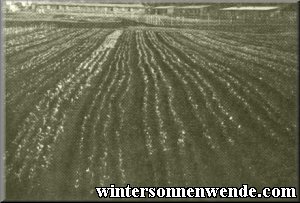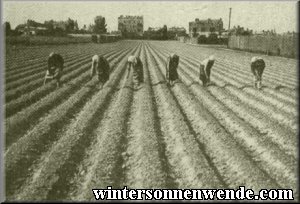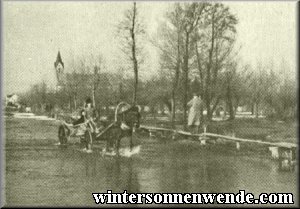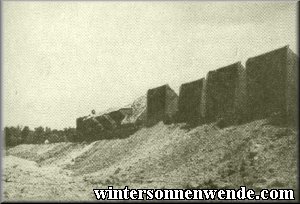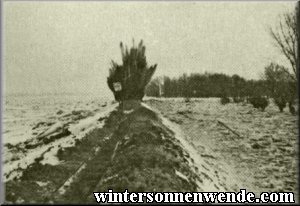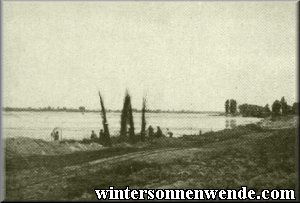 |
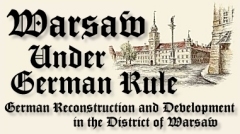 Politics of Food Supply in the District of Warsaw
1. General Problems of Food Supply
Unfortunately this is not so. Rather, it is a hard struggle for the General Government just to achieve self-sufficiency in the provision of food for its own population. Granted, the population density in the General Government is not quite as great as that in the Reich, but so far the agricultural yield per hectare* has not been half of that in the Reich. The reason for this is largely that agriculture in the former Republic of Poland was always characterized by very extensive cultivation which in no way approximated the exhaustive land use typical of the intensive cultivation practised in the Reich. Added to this is the fact that the agrarian structure of the former Polish Republic was extraordinarily unfavorable. The principal feature of this structure is the great number of tiny farms: some 22% of the farms are smaller than 2 hectares, and approximately 75% of all farms are between 2 and 50 hectares in size, so that only 3% are large farms of more than 50 hectares. A further detriment to agrarian structure has been the fragmentation of landholdings, the degree of which is simply unimaginable from a German point of view. Even the smallest farms are subject to division among multiple heirs, resulting in tiny plots whose cultivation is immensely difficult.** There have been cases where a farm of only 10 hectares was stretched out in a strip no less than 45 km. long. It goes without saying that such a structuring of the individual farms renders cultivation extraordinarily difficult and results in correspondingly smaller yields. These general problems, which apply to the entire General Government, are exacerbated by further problems specific to the District of Warsaw. Whereas in the other districts of the General Government some 70–80% of the population are agricultural producers and only 20%–30% are consumers, the situation is reversed in the District of Warsaw: the greatest part of the populace, 65%, are consumers and only 35% are producers who secure their own livelihood by agricultural activities. The population of the District is more than 3.3 million. Particularly for the District of Warsaw the war has been very damaging to matters of food supply policy; the former resource areas for the great city of Warsaw had used to be the Warthe [now Warta] region and the present-day administrative division Zichenau, which have been incorporated into the Reich. The hinterland of Warsaw from which this city draws the bulk of its food supply has become very small due to the loss of these agriculturally rich regions. The District's agriculturally productive land now amounts to no more than 1.2 million hectares. In the course of the Polish Campaign, most of the groceries and agricultural products present in the District at that time were consumed or destroyed. Also, many agricultural enterprises were completely destroyed because the battle had raged the longest in the District of Warsaw; and the many troop movements also contributed their share to the consumption of the last remaining supplies. In their retreat across the River Bug, the Soviet troops took great numbers of livestock and vast quantities of grain and fodder with them into what was then the Russian area of interest, rendering the District almost devoid of livestock, grain and fodder in the process. What little was still available then was completely bought up by the starving masses that flocked to the various counties of Warsaw after the end of the city's siege.
 2. Measures to Increase Agricultural Production After the end of hostilities, when the civil administration took over the District of Warsaw, agricultural production in particular was in a desolate state of affairs.
In the autumn of 1939 the foremost concern was to resume the fall tilling so that no great loss of crops would occur the following year. And in fact it was possible, by dint of great exertion, to complete 85% of the 1939 fall tilling; the supplies required, however – such as machinery, seed, artificial fertilizer, etc. – had to be largely provided by the Reich. Extensive measures aimed at increasing agricultural yields have been put into place in the past three years. To gain some idea of the supplies that were required to achieve the harvest of 1940, one need only consider the following statistics: a total of 30,800 tons of artificial fertilizer were used, as well as 5,170 tons of seed potatoes, 1,100 tons of seed oats and approximately 800 tons of seed barley, not to mention the considerable quantities of intercrop seed of all kinds. Breeding stock was also imported from the Reich to improve the livestock. While the primary concern in 1939–40 was the stock-taking and care of the larger agricultural enterprises, the many smaller farms were eventually also included in this productivity assessment. There was simply not enough manpower to include these from the first as well. There are 1,221 large agricultural enterprises in the District; these take up only 3.2% of the total productive area, while the more than 150,400 small farms undertake to cultivate no less than 96.8% of the arable land. In the period following, particular attention was devoted to these small farms as the success of the agricultural production campaign depends largely on their effective incorporation and management. Much has been done in all these respects. In the field of stockbreeding, it shall suffice to mention the increased import of high-quality breeding stock from the Reich, the introduction of standards for the selection of breeding stock, the systematic promotion of small animal breeding and the introduction of compulsory milk quality testing for dairy farms of 25 hectares and larger. As regards farming and horticulture, the intensity of cultivation was advanced primarily through the import of modern machinery and high-quality seed from the Reich. Beyond that, local production of the most important crops which previously had had to be imported from outside the boundaries of the present General Government was effected through the reorganization of crop planting ratios. The area planted with sugar beets alone was increased from 7,500 to 13,500 hectares. Similarly, the growing of oil-producing plants was increased from 4,500 to 7,000 hectares, which has gone a long way towards closing the gap between the demand for and the supply of fats and oil. Increasing vegetable-growing to 11,000 hectares has made the supply of food to Warsaw much less problematic. That it has already been possible to greatly increase production in these first few years is due largely to the measures taken by the Property Administration. The Property Administration has taken over the entire agricultural possessions of the former Polish state as well as the abandoned agricultural property and particularly the Jewish landholdings. It has also taken over such agricultural establishments as were deeply in debt and whose continued proper cultivation was doubtful. Altogether, 244 estates with a combined land area of 74,128.65 hectares and some 2,000 resettlement farms totaling approximately 15,000 hectares have been taken over to date in the District of Warsaw, so that the total area of all farm holdings under the Property Administration's care comes to some 90,000 hectares, of which about half can be considered to be agriculturally productive land. The state of neglect which characterized these farms when the Property Administration took them over is revealed by the following typical example: on a large, formerly Jewish-owned farm which had a potential productive land area of 1,020 acres, only 11 ricks of grain were harvested in 1940. Under the management of the Property Administration, that same farm already produced 64 ricks of grain in 1941, an increase of almost 600%. At the end of 1940–41, 105 of the 109 independently managed farms required subsidies totaling some 8 million zloty. The budget estimate for 1941–42 allows for an average subsidy of 250 zloty per hectare of agriculturally productive land. The existing stock of livestock and equipment had to be supplemented everywhere. In terms of large machinery, more than 60 tractors and 30 threshers were bought by March 31, 1942. More large machinery is on order. Livestock ownership is still completely inadequate on most farms. However, it is impossible to increase the numbers of livestock to normal levels as the farms are not yet capable of producing enough livestock feed on their own. The following list shows how favorably the numbers of livestock have changed as a result of the measures taken by the Property Administration. On the estates under the Property Administration's care, there were:
Despite the difficulties which have cropped up in the past few years – whether it be in the supply of seed, artificial fertilizer, or other agricultural requisites –, great progress has nevertheless been made. But it will still be quite a long time before all farms function normally.
 3. Land Mangement and Water Economy Aside from the measures serving to regulate the day to day cultivation of the land, everything possible must be done to improve the overall structure of the agriculturally productive land. In this respect, land management and the supply and distribution of water take on particular importance, for a truly permanent increase in the productivity of the existent agricultural land can only be achieved following the implementation of the measures pertaining to these areas of concern. As already mentioned, a large part of the District of Warsaw consists of a host of tiny farms made up of many fragmented plots. The cause of this structure is to be found in the former government's flawed agrarian policy which was not far-sighted enough to prevent the repeated fragmentation of farmland from one generation to the next through the practice of inheritance division. This practice began in 1864, the year in which a decree issued by the Czar revoked state ownership of the land and granted the peasants the right of free disposal of their land. Besides inheritance fragmentation, the practice of buying and selling land freely had naturally sprung up since that time and, being in no way restricted by any laws to the contrary, had contributed further to the fragmentation of landholdings. Until 1891 no law was enacted to place any limits on the right of disposal of the land which had come under private ownership through the decree of the Czar. In 1919 a law similar to the German Real Estate Sales Act of 1918 was passed, according to which a permit had to be obtained before real estate lots of more than 10 hectares could be sold. But this did nothing to eliminate the fundamental problems, namely inheritance fragmentation and the uncontrolled sale of small plots of land; on the contrary, the situation became downright intolerable. In order to effect a fundamental change, agricultural reforms were introduced in 1920 which resulted in several laws but again had little success. These reform laws set an upper limit of a few 100 ha as the most land any one person could own. Any excess was parcelled out or turned into independent adjoining smallholdings. At the same time, land combination and reorganization programs were to create functional farming establishments. 62,000 hectares of private and 7,685 hectares of state-owned land were parcelled out and distributed. But since the practice of inheritance fragmentation continued unchanged, these agricultural reforms were also doomed to fail. An order forbidding the mortgaging and division of land (albeit only land that had been parcelled out) was passed in 1932, but again failed to improve the situation. Likewise, the improvements resulting from the combining and reorganizing of plots were only short-lived, as the fragmentation process resumed immediately following this reform measure. For this reason one still finds farms today which not only consist of a great many parcel lots but whose individual lots are also up to 10 km. distant from each other. These lots again consist of strips which are very narrow, but kilometers long. After the General Government was established, one of the first measures to be taken was therefore the regulation of real estate transfer according to uniform guidelines. It was ordered that large farms were not to be divided further into smaller lots, as well as that small farms of 3 to 5 hectares were not to be fragmented into even smaller sections, whether through sale or through division among the children entitled to inherit the parental estates. Also, those cases of land parcelling which have not yet been entered into the land register will not be continued and are to be rescinded if at all possible. After the decree of March 27, 1940 had thus regulated the transfer of land in the General Government, the efforts at combining and reorganizing plots could be successfully resumed. At first it was rather difficult to continue those reorganization measures which Polish authorities had begun, as many of the original land surveyors and engineers had been killed in the war or had fled and many important plans and documents had been lost, so that the most important task initially was to locate and remobilize the remaining specialists and to determine the status of the previous work. Only then could on-site work resume. Such work soon included 235 lots with a total area of 135,000 hectares, from which 72 lots totaling some 29,000 hectares have been created to date. Aside from the small-scale reorganization projects, new large-scale projects have been begun. One of these, involving 20,000 hectares in the county of Grojec, has already made considerable progress; the other, in the county of Sochaczew, involves the restructuring of 15,000 hectares. Clearly a fundamental reconfiguration of land ownership conditions in a relatively small area is impossible to carry out completely if, as already mentioned, the lots belonging to a single agricultural enterprise are separated by distances of 10 to 15 km. The same holds true for the reorganization of road and traffic conditions, which can of course only be effected on a large scale. Further, almost all collective communities contain many lots whose owners reside in neighboring communities or nearby cities. Here too, small-scale reorganization projects are unable to bring about any fundamental changes. Soil improvement and conservation projects, which are necessary on a large scale and which always have as their prerequisite the elaboration and consolidation of the drainage system, require the areas intended for reorganization to be as large as possible. The land reconfiguration projects require very extensive work on soil conservation and drainage. This is the responsibility of the Water Economy Administration, whose measures are vitally important in order to increase agricultural yields. The Water Economy Administration is responsible for the following:
As early as the beginning of winter 1939–40, the damage which the dikes had sustained during the war was repaired as far as the frost would allow, and preparations for dealing with the heavy ice drifts and high water expected as part of the spring thaw were also begun during the winter. By virtue of these preparatory measures it was possible to prevent the flooding of all those polders that are now protected by dikes of sufficient height and strength. There are, however, a large number
In 1940, on the basis of construction programs already submitted in the winter of 1939–40, the Water Economy Administration was heavily subsidized by the Governor General. Of the total funds, which amounted to 57 million zloty for the entire General Government, the District of Warsaw received 10 million. From the start, the financing of construction projects has been handled in a fundamentally different way in the General Government than in the Reich. In the Reich only environmental associations are responsible for land improvement programs; these associations generally provide only a small share of the capital required, and the rest is in part lent by a credit institution and in part provided as grant by the Reich, that is, by the state. In the General Government the state itself takes sole financial responsibility, funds and carries out the approved meliorations itself, and later sets up associations and organizations which must repay, and pay the interest on, part of the expenditures. This method is easier in every respect and also permits the work to begin without delay. Another kind of melioration – land drainage – was also in a bad way in Polish times. Proper drainage, an important and also very fast-acting improvement, is able to increase crop yields dramatically: on a single hectare it can increase the yield of grain by 800 kg. and the yield of potatoes by 6,000 kg. As early as 1930, drainage works had come to a complete standstill in Poland because from a liberal point of view the drop in prices for agricultural products in Poland rendered it no longer worthwhile. It was thus particularly difficult to resume work on this agricultural necessity because no brickworks were equipped to produce drainage pipes, and trained drainage workers as well as specialized tools were hard to come by. Surprisingly, however, these difficulties have also been brought under control, and some 32 different areas totaling 3,400 hectares have been drained to date. In 1940 the Water Economy Administration worked on more than 100 sites throughout the District. 46,7 km. of dikes were constructed, 134.7 km of rivers were meliorated and 682.2 km. of ditches shored up. Altogether, 1,771,555 cubic m. of earth was moved in the process. 22,479 cu.m. of fascines [brushwood bundles] were placed along slopes to prevent erosion; 149 km. of wattle fence were erected; 360,000 sq.m. of embankment were covered with turf, and a further 6,265 sq.m. were paved. 190 ducts totaling 1,000 running meters in length were laid down, 11 concrete and 25 wooden bridges built, and 140 bottom plates made (of these, 12 were of concrete). Further, 660 hectares of waterlogged land was drained, requiring the laying of drainage pipes totaling some 400,000 running meters in length. 7 concrete and 4 lumber moorages are under construction. 1,100 hectares of land were broken up, fertilized and sown, and a further 500 hectares were ploughed. The equivalent of 660,000 days of work went into these programs, which cost a total of 10,000,000 zloty. Further plans were drawn up and tested during the winter of 1940–41 to ensure a sufficiently full agenda for the next year. In 1941 fairly large numbers of Jews from the Jewish Quarter of Warsaw were called in to work on the programs of the Water Economy Administration. But this turned out to be a big mistake. No less than half of them were physically unfit to work; others fell ill. The work performance of the remaining Jews was so poor that even just the cost of the rations they consumed was greater than the value they produced. In future, Russian prisoners of war will be called in for this work, rather than the Jews. The present problems of food supply can clearly not be resolved overnight by these long-term projects, some of which are expected to take decades; it is impossible to make up in a few years of reconstruction and development what a century of Russian rule and 20 years of the Polish Republic neglected. But the German administration has set itself the several years' goal of agriculturally restructuring the territory of the General Government in such a way that this region can then completely fulfill its obligation to feed its population, without subsidies from the Reich or contributions from other regions. The General Government has no coal or ore deposits worth mentioning. The region's greatest asset is its soil, which still has vast production potential untapped by Polish mismanagement. The great future responsibility which awaits us Germans is the development of this great resource. The initial successes which have already been achieved guarantee that the ultimate attainment of this great goal will draw nearer with each passing year.
 *[Trans. note:] 1 hectare = 2.471 acres. ...back...
**[Trans. note:] The original text was incompletely typeset at this point. The preceding sentence had to be reconstructed from the context and may not be word for word what the author originally intended. ...back... |





